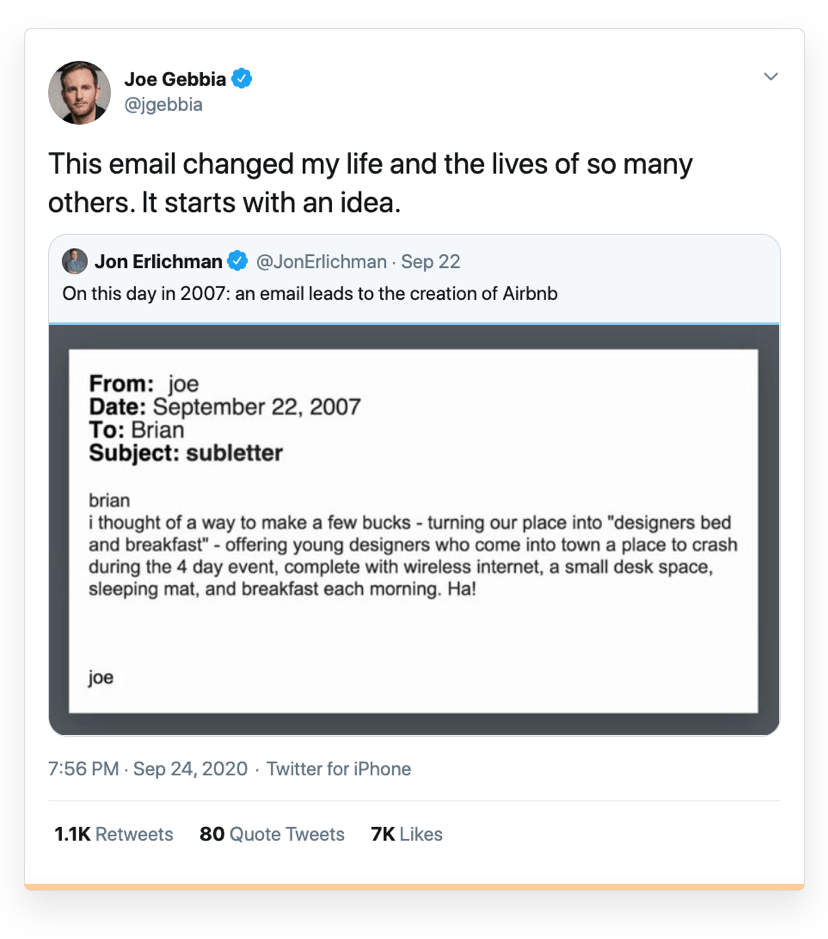How to build a website like Airbnb
The technology to build a website like Airbnb is available to anyone. How to get the business side of things working—that’s the hard part. This guide helps you do both.
Airbnb is a phenomenal business.
In 2024, over 490 million nights and experiences were booked on Airbnb, generating more than $11 billion in revenue. Beyond the platform, Airbnb guests contributed significantly to local economies, spending an estimated $80 billion on goods and services in 2023.
But when Airbnb first got started, online marketplaces were a budding trend. No tools or guidebooks existed, and the founders had to invent and build everything from scratch. Today, Airbnb employs over 1,200 developers.
The good news is that today’s marketplace founders are in a much better position to start a website like Airbnb. Marketplace builders like Sharetribe let you launch, run, and grow a marketplace website like Airbnb—at a fraction of the time and cost.
The hard part is getting a two-sided marketplace business like Airbnb off the ground. Building a marketplace is much harder than building a regular e-commerce store.
With this guide, we want to help you with both. Our goal is to help you achieve two things:
- Find the best way to build a website like Airbnb for your idea, requirements, skills, and budget
- Learn how to crack the challenges inherent in the two-sided marketplace model and build a successful marketplace business
We’ll draw on lessons from Airbnb’s successful history and our 10+ years of experience working with successful marketplace founders.
We hardly need to cover the basics: Airbnb connects hosts and guests and facilitates their transactions. This makes Airbnb a two-sided online marketplace. The business model relies on charging a commission (or service fee) for each transaction that takes place through the platform.
More specifically, Airbnb is a location-based peer-to-peer rental marketplace. This has some implications for building a website—and a business—similar to Airbnb, so let’s quickly define all three concepts.
In a nutshell, Airbnb can be described as a:
- location-based
- peer-to-peer
- rental marketplace
Location-based means that the customer needs to be at the same location as the listing to make a transaction. This affects both feature requirements and business strategy.
Peer-to-peer describes Airbnb’s primary user groups. On peer-to-peer marketplaces, private individuals can act as sellers, buyers, or both. B2C (business-to-customer) or B2B marketplaces (business-to-business) can also be successful, but they might require slightly different functionality than a peer-to-peer platform.
A rental marketplace connects people with idle assets with those who want to rent those assets. A rental website needs different features from product-selling marketplaces like Amazon or eBay. The rented property can be some type of space, like swimming pools or music studios, or physical items like clothing or cameras.
Airbnb’s success isn’t just the result of a great idea. It’s the product of a carefully designed business model, a strong trust infrastructure, and a platform that scaled smoothly with global demand.
At the core of Airbnb’s model is its role as a trusted middleman. Guests and hosts transact directly, but Airbnb handles payments, opens up communication, and ensures accountability for peace of mind on both sides.
Here are the main elements of Airbnb’s platform that contribute to its success:
- Escrow-based payments and flexible booking: Airbnb collects payment from guests at the time of booking but doesn’t release it to the host until after check-in. This protects both parties and helps resolve disputes quickly.
- Two-way reviews and accountability: After every stay, guests and hosts review each other. Reviews are only published once both sides submit them (or after a set time) to encourage honest feedback and build a transparent reputation system.
- Scalable supply model: Anyone can list a space—no licenses, contracts, or inventory management required. This open model has helped Airbnb grow a vast supply of accommodations in nearly every corner of the world, from major cities to remote villages.
- Global-local hybrid support and branding: Airbnb balances a strong global brand with tools and content tailored to local contexts. The platform is available in multiple languages, supports local currencies and payment methods, and provides country-specific help content. Their customer support also spans time zones to address issues quickly.
You can find more inspiring examples of Sharetribe-powered marketplaces by browsing our customer gallery and founder stories.
Now, with these building blocks in mind, let’s look at what the process of building a marketplace similar to Airbnb could look like.
In our experience working with successful founders, building a marketplace business like Airbnb happens through 10 steps:
- Find a strong marketplace idea
- Choose the right business model
- Start with a focused scope
- Pre-validate your marketplace idea
- Build your marketplace platform, starting with a Minimum Viable Platform (MVP)
- Onboard your first sellers (or the “hosts” on Airbnb)
- Launch your marketplace to customers
- Reach problem-solution fit
- Reach product-market fit
- Scale into new markets
Next, we’ll explore each step through the lens of a rental marketplace business like Airbnb and offer practical advice along the way.
These steps are based on our complete guide to starting a marketplace, which you should check out for a more in-depth discussion and lots of inspiring additional resources.
Airbnb is an inspiring example of the power of a great idea. What started from a simple email is now a global, multi-billion-dollar business.
In 2007, an upcoming design conference filled up hotel rooms in San Francisco. Roommates Brian Chesky and Joe Gebbia decided to earn some extra cash by offering to host attendees on air mattresses.
The idea led to a simple website inviting three people to stay at Chesky and Gebbia’s flat. A year later, Nathan Blecharczyk joined to start building the foundation of a two-sided marketplace website.
The rest is history, with many entertaining stories from selling breakfast cereal to getting rejected by famous VC firms before reaching a valuation measured in billions.
Today, launching a website like Airbnb is much easier, quicker, and more affordable than in 2007. But the very first step—how the founders came up with a great idea—is as relevant as ever.
Chesky and Gebbia got the idea for Airbnb by identifying an underused asset: extra space people had in their homes. In our experience, this is a very common way founders land on marketplace ideas: they look around and spot inefficiencies.
Another road to a great marketplace idea is identifying a problem founders have themselves—and how a marketplace could solve it. Chesky and Gebbia got their idea by looking at the empty space in their own apartment. They also quickly realized that the buyer side of the marketplace had a problem too: difficulty finding hotel rooms during peak demand.
These days, we also often see a third path: identifying a niche market that is poorly served on existing platforms (or improving an established player’s offering).
The latter is how many interesting Airbnb competitors have emerged—Sharetribe customer Socialbnb is a great example.
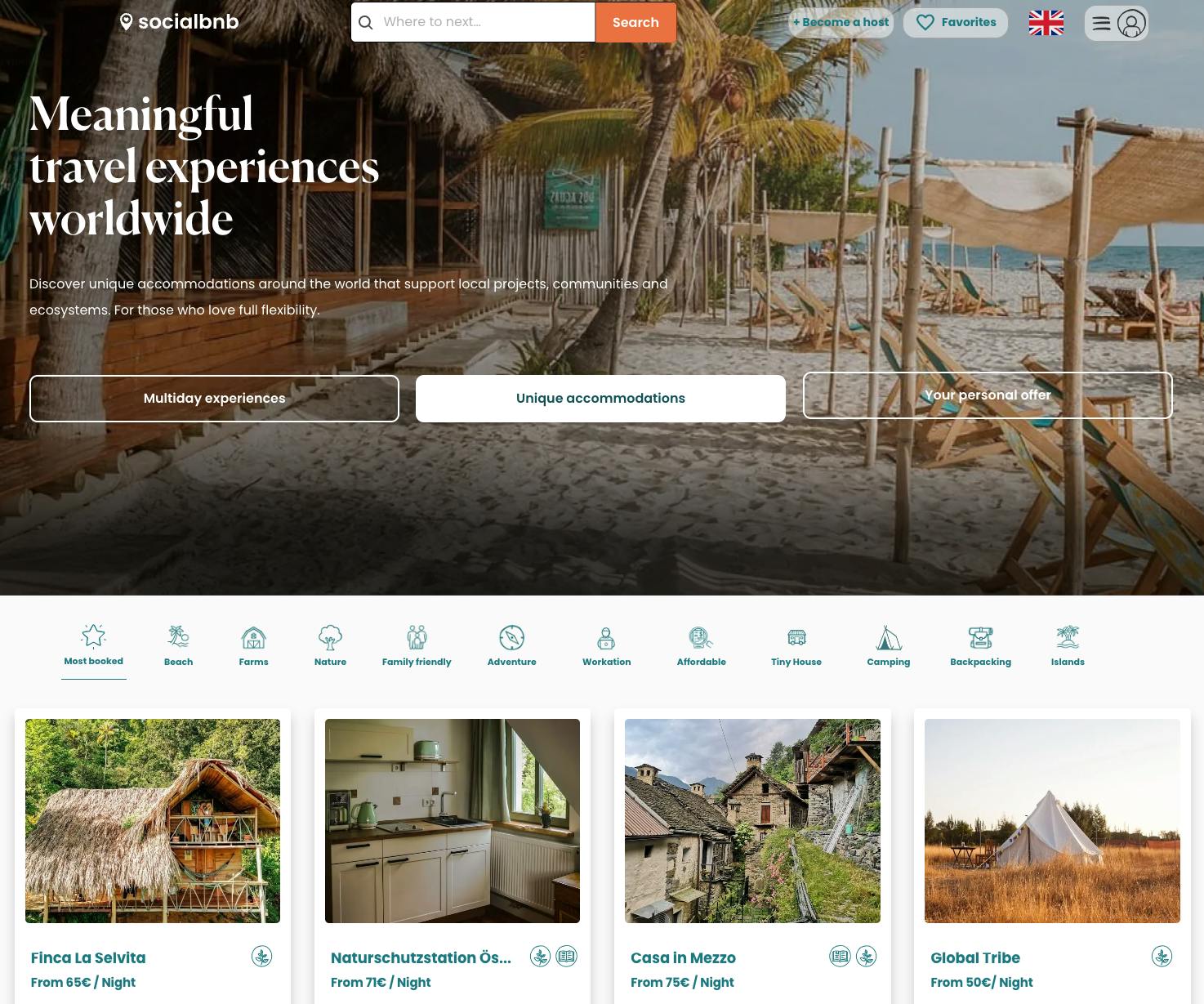
In a nutshell, a great marketplace idea is the result of four factors:
- It solves a real problem for both sides of your marketplace (supply and demand).
- It targets a large enough market that matches your business goals.
- The market is fragmented (with many suppliers and customers).
- There’s potential for frequent usage (which leads to repeat purchases).
When you start looking at the world through the eyes of a marketplace founder, you'll likely start noticing ideas everywhere.
Here are some more ideas for peer-to-peer rental marketplaces to inspire you:
- Experiences or activities
- Guided tours
- Car rentals
- Van or RV rentals
- Creative studio spaces
- Coworking spaces
- Camping gear
- Photo and video equipment
A great business idea is only great if there’s a way to monetize it. At Sharetribe, we studied how the top 100 marketplaces in the world monetize their platforms.
We found that most use one or several of the following revenue models:
- Commission: charging a flat fee or a percentage of each transaction
- Membership: charging a subscription fee for joining the platform
- Listing fee: charging a fee when a provider posts a listing
- Lead fee: charging sellers for access to buyers
- Freemium: charging for additional features while core features are free
- Featured listings/ads: charging providers or other businesses for visibility
We also found out that commission, the model also used by Airbnb, is by far the most widely used.
Airbnb charges a commission, which it calls a service fee, from both hosts and guests. Similarly, platforms like Amazon, Etsy, Upwork, and Fiverr all use commission as their primary revenue stream.
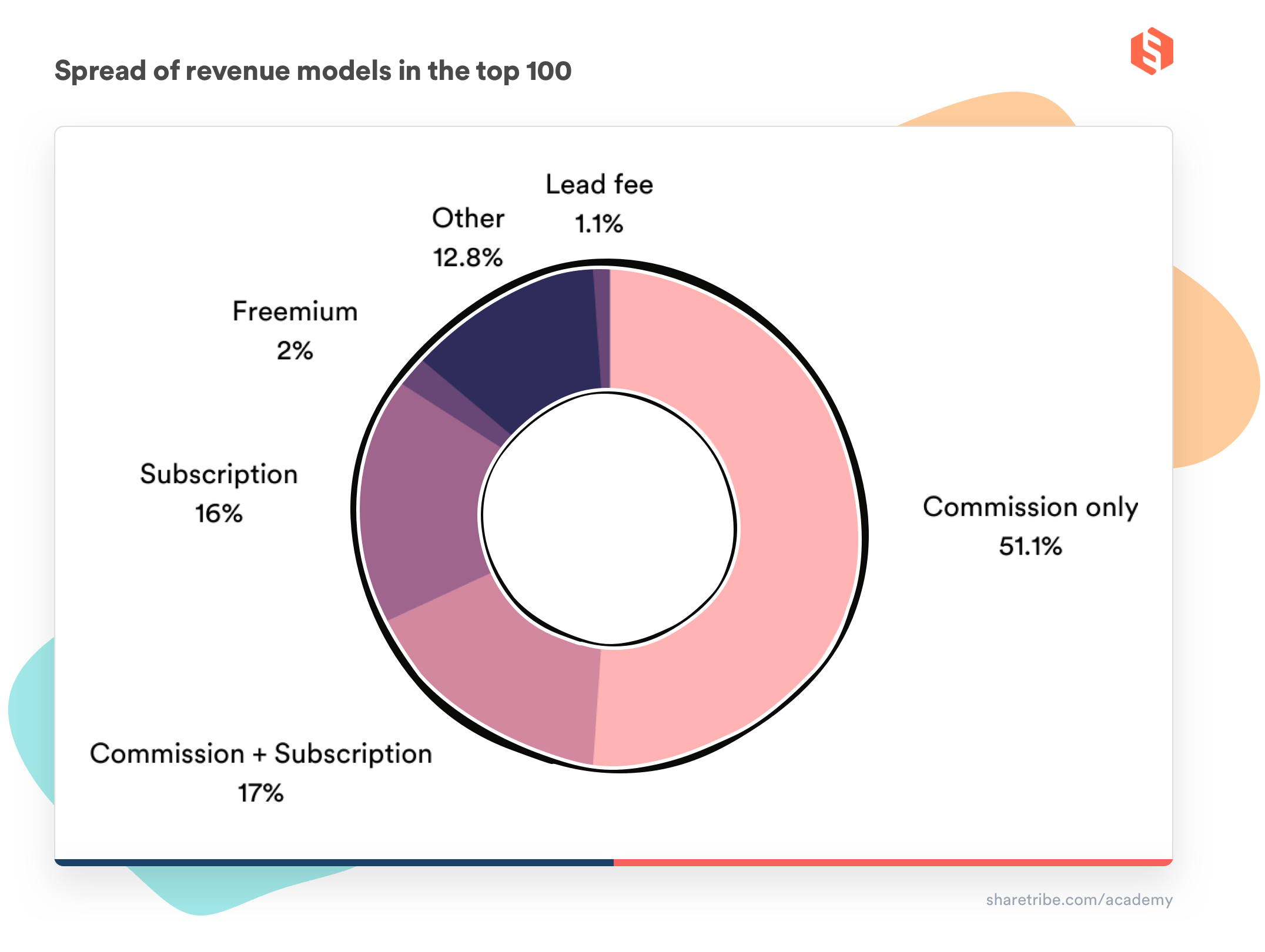
Commission is a popular business model for a reason.
First, it poses a minimal barrier of entry to new users. Especially in the early stages, marketplaces typically charge a commission from the supply side only. This makes signing up for the platform easy: buyers don’t need to pay extra to transact on the platform, and sellers only pay a fee when they make money.
Commission also tends to be the most lucrative business model. The website owner gets a piece of all the value that happens in the marketplace.
There are a couple of inherent challenges to this model, too.
The commission model exposes a marketplace to the threat of marketplace leakage: users taking payments offline to bypass your commission fee. Airbnb and similar marketplaces combat this challenge by offering so much value that going around their payment systems isn’t worth the trouble for users.
Another challenge is that the commission structure is very complicated to implement from a technical and legal standpoint. We recommend integrating your platform with a third-party payment provider that has a dedicated payment product for marketplaces and platforms. Otherwise, there’s a risk that you can’t charge your commission in a way that complies with local and regional online payment regulations.
Needless to say, Sharetribe has built-in support for the commission business model and an integration with Stripe Connect to process payments safely and reliably. (It’s also very easy to build flows for membership, listing fee, and lead fee models without coding on Sharetribe, if you’re considering those revenue strategies.)
For more on marketplace business models and the payment infrastructure, check out our resources on marketplace business models and marketplace payments.
Airbnb is a global marketplace. As a customer, you can find a place to stay on Airbnb almost anywhere you can imagine traveling.
This might make the next piece of advice seem counterintuitive, but we’ve heard it from almost every marketplace expert, investor, and founder we’ve talked to.
That advice is: start small.
Instead of targeting the entire world right away, focus on a single region, country, or even a single city or neighbourhood.
The logic behind this is that the most challenging part of building a marketplace is getting both sides of the business working. You need to have enough supply to attract demand and enough demand to keep your supply happy.
It’s much easier to crack this challenge with a small initial user base. And it will be much easier to expand your platform when you have established a small but strong user base that loves your platform.
In fact, this is exactly what the Airbnb founders did. They started in San Francisco, where they knew the yearly event calendar, the hotel market, and its shortcomings.
As startup guru Paul Graham told Airbnb founder Brian Chesky: “It’s better to have 100 people love you than a million people sort of like you.”
Once you’ve identified your idea and revenue model and decided on the initial scope, take some time to pre-validate your concept. This will help you avoid spending time and money on the wrong things.
In the pre-validation stage, the goal is to validate whether you’ve made the right assumptions about your audience, their problems, and their willingness to pay for the solution you’ve devised.
Here are the steps:
- Find and talk to your target audience in person and online. Starting small makes this much easier: you can engage your target audience in online forums and groups, or meet them live.
- Ask if people have the problem you think they have, and how they’re solving it now. Then, pitch a prototype of your idea and listen to their feedback.
- If the feedback shows some of your assumptions were wrong, change your approach and validate again!
In terms of what you should ask them, we recommend open-ended questions like:
- How do you currently find the rental (or product or service)? Is it easy?
- How do you compare different locations (or again: products or services)?
- Could you take in more customers than you currently have?
- How do your customers currently find you?
As you research your target market, you may find another marketplace already operating in your space. Don’t let that discourage you. If you can solve the problem better than any other existing solution, you have a window of opportunity. So learning how your competitors do it can offer key insight into how your marketplace can offer an improvement.
As you can see, you can get some validation for your idea before building anything.
But at some point, you’ll have exhausted the learning opportunity that comes from just talking. The next step is to build something and see how users engage with it.
The best way to start a marketplace like Airbnb is in stages. Once you’ve pre-validated your idea, you want to get the first version of your website out into the world as quickly as possible so you can continue learning and fine-tuning your concept.
This version is called the Minimum Viable Platform, or MVP.
The list of key things your first version has to achieve is rather short. Your marketplace should be able to:
- Communicate your value proposition: Your landing page should clearly explain what your marketplace does and who it’s for.
- Enable core actions: Users need to be able to find, create, and book listings.
- Facilitate payments and take a cut: If your business model is commission-based, your MVP should support payments from day one so you can validate your revenue stream.
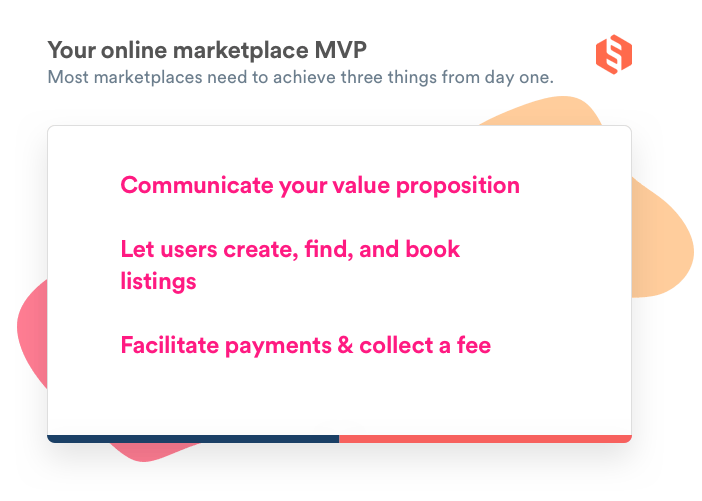
In the MVP stage, it’s fine to do things manually, even if you plan to automate them later. Again, the goal is to get something live quickly (without spending your entire budget on it).
That said, even at the MVP stage, your platform needs to be compliant. Depending on your region and business model, you’ll need to consider things like clear terms of service, data privacy compliance (like GDPR), handling VAT or sales tax, and any relevant insurance or liability disclaimers. You should at least consult a legal expert before launch. It’s much easier to get these foundations right from the start than to backtrack later.
User experience is equally important. Trust is everything in a marketplace, and much of that trust is built through design. Your platform should be clean, intuitive, and easy to navigate on any device. Users should be able to move through your core flows—searching, booking, messaging—without confusion or friction. Accessibility should also be a priority: your design needs to work for all users, not just the average one.
You don’t need to reinvent the wheel to get this right. Sharetribe is a great solution for this, for a few reasons:
- It has all the functionality you need for a location-based peer-to-peer rental marketplace like Airbnb from day one, without any coding.
- It’s infinitely scalable and expandable—once your business takes off, you don’t need to rebuild everything from scratch. You can add custom designs, features, and functionality on top of the no-code essentials.
- It includes customizable elements that follow well-established UX design patterns, including responsive, mobile-friendly layouts; clear listing and profile pages; structured search and filtering tools; built-in reviews, messaging, and booking flows; and admin dashboards.
- It’s reliable and easy to maintain. Whether your marketplace has 10 users or 10 million, Sharetribe takes care of your backend infrastructure.
But then again, we’re biased. So let’s look deeper into what features a marketplace like Airbnb needs and what options you have for building them, aside from Sharetribe.
The features on Airbnb are very different from those offered by traditional online stores and product-selling marketplaces. Your rental marketplace will likely need some of these features from the start.
These days, Airbnb has a wide variety of functionality that has been built over the past decade. But it’s important to remember that Airbnb did not start with all this functionality in 2008. Instead, they iterated and improved based on user feedback, as this tweet from Brian Chesky illustrates well.
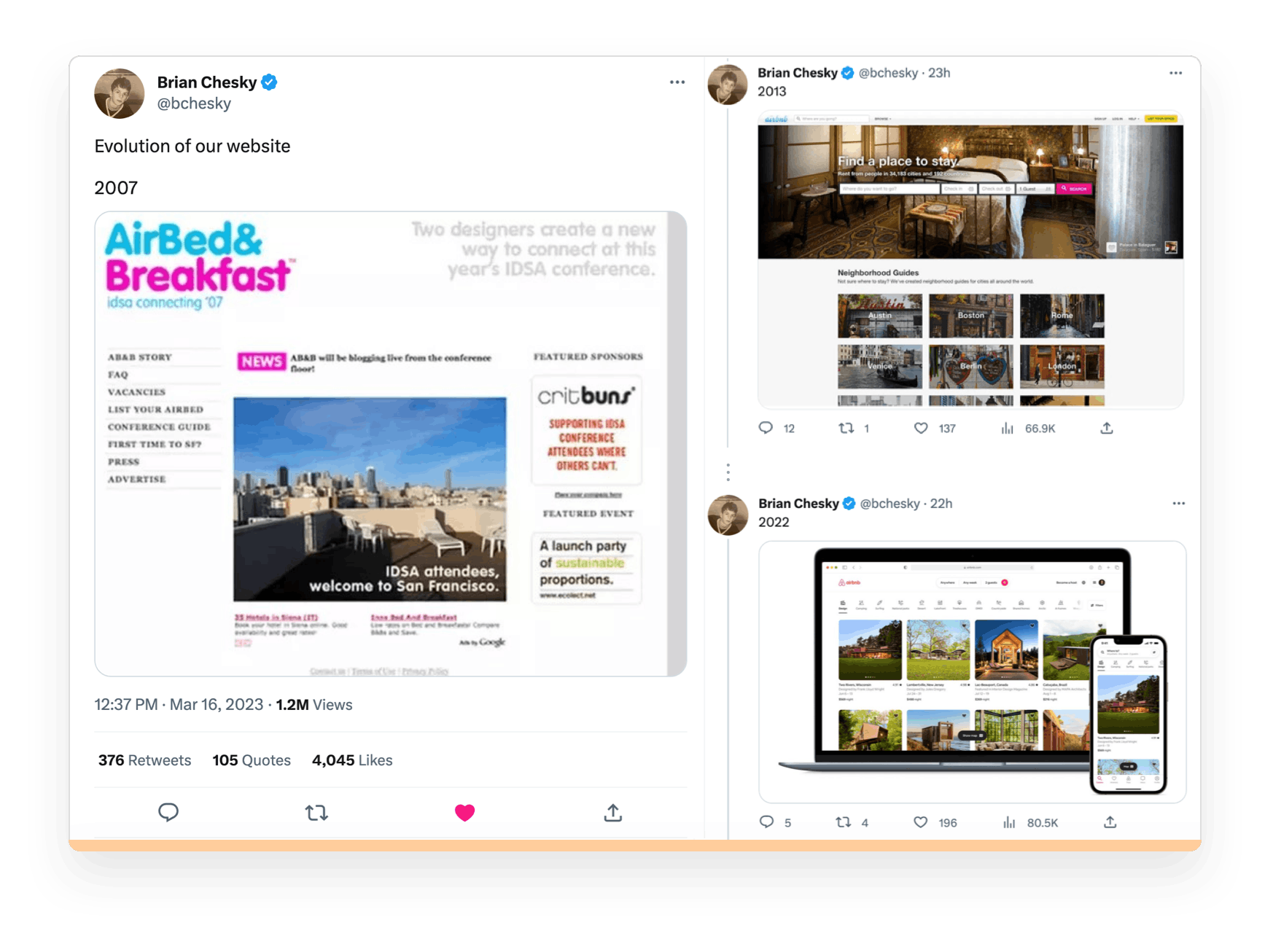
So, when defining the features your marketplace needs, focus first on the core functionality. What is absolutely vital to have on day one? And what can you build later once you’ve validated your marketplace idea and have the revenue or funding to finance additional development?
Here is our list of the core features of Airbnb:
- Profiles and listings
- Map and location search
- Online payments (with delayed payments and holding funds)
- Availability and booking management
- Two-sided reviews
- Admin tools
On Airbnb, a huge number of customers and providers interact and transact with each other. To list or book a rental apartment, users need to:
- Create an account
- Create and update their listings (the rental properties)
- Publish and update their user profile
Informative, nicely designed profile and listing pages help boost your marketplace’s conversion rate and increase trust between users.
Here’s an example of how profiles and listings look on Biketribe, Sharetribe’s rental marketplace website template that works very similarly to Airbnb.

On traditional e-commerce marketplaces like eBay, location doesn’t matter, as the products sold can be shipped worldwide. On location-based marketplaces like Airbnb, the guest and host will need to meet for a transaction to succeed. Or the guest at least needs to physically be at the host’s rental property.
This means a location-based marketplace can’t get by without a powerful, location-based search engine that allows users to look for listings in their ideal location. Showing the listings on a map is essential as well.
Here’s an example of what this feature might look like using Sharetribe.
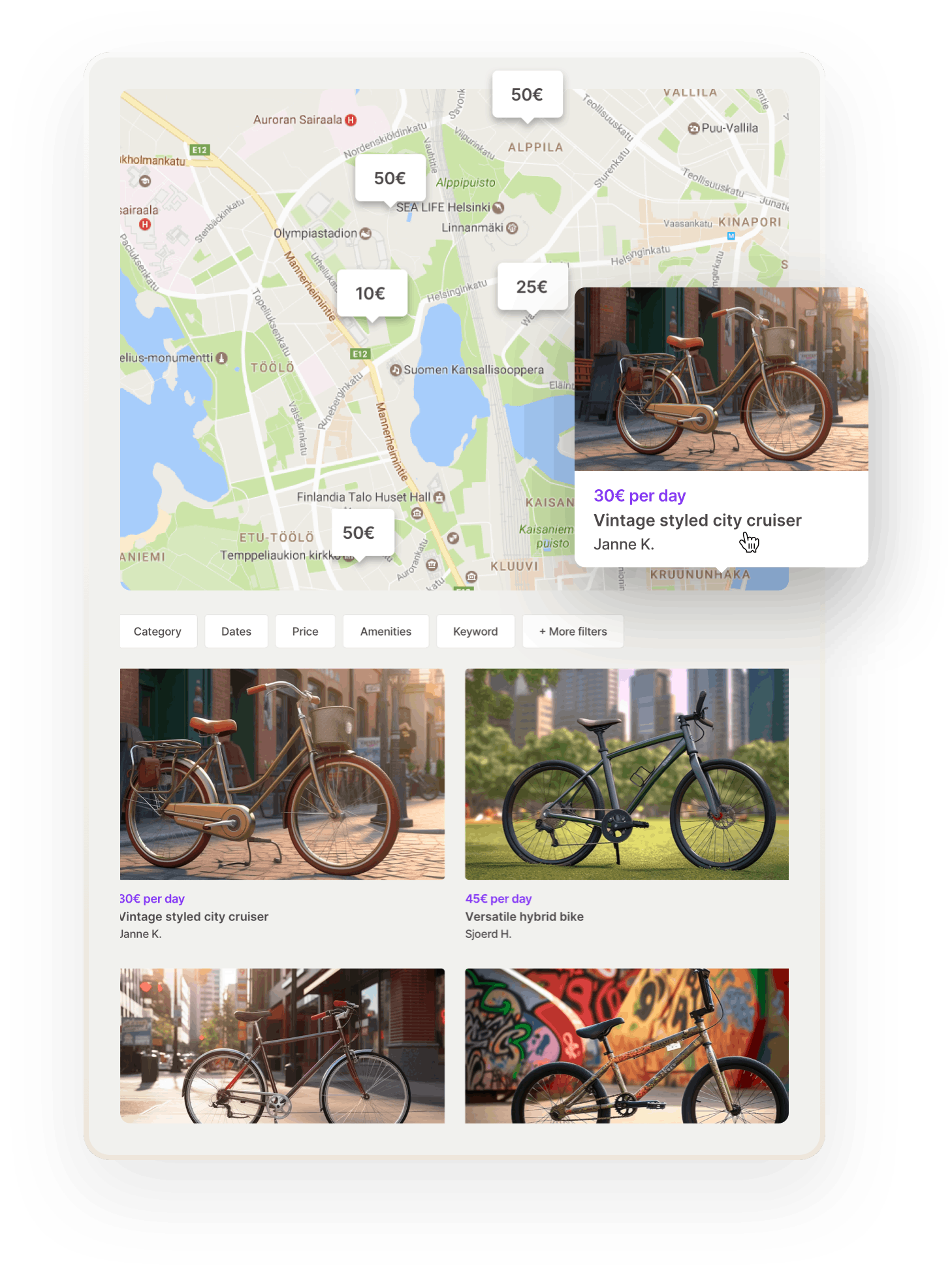
When a marketplace offers services or rentals, sellers need a reliable system to specify when their listings are available. Buyers should only be able to browse and book listings that are available during their desired dates. When a listing is booked, it should automatically be marked as unavailable for that period.
This feature is a crucial part of the value proposition of a rental marketplace like Airbnb. It helps hosts make the most of their rentals, boosts successful transactions, and avoids frustrating double bookings.
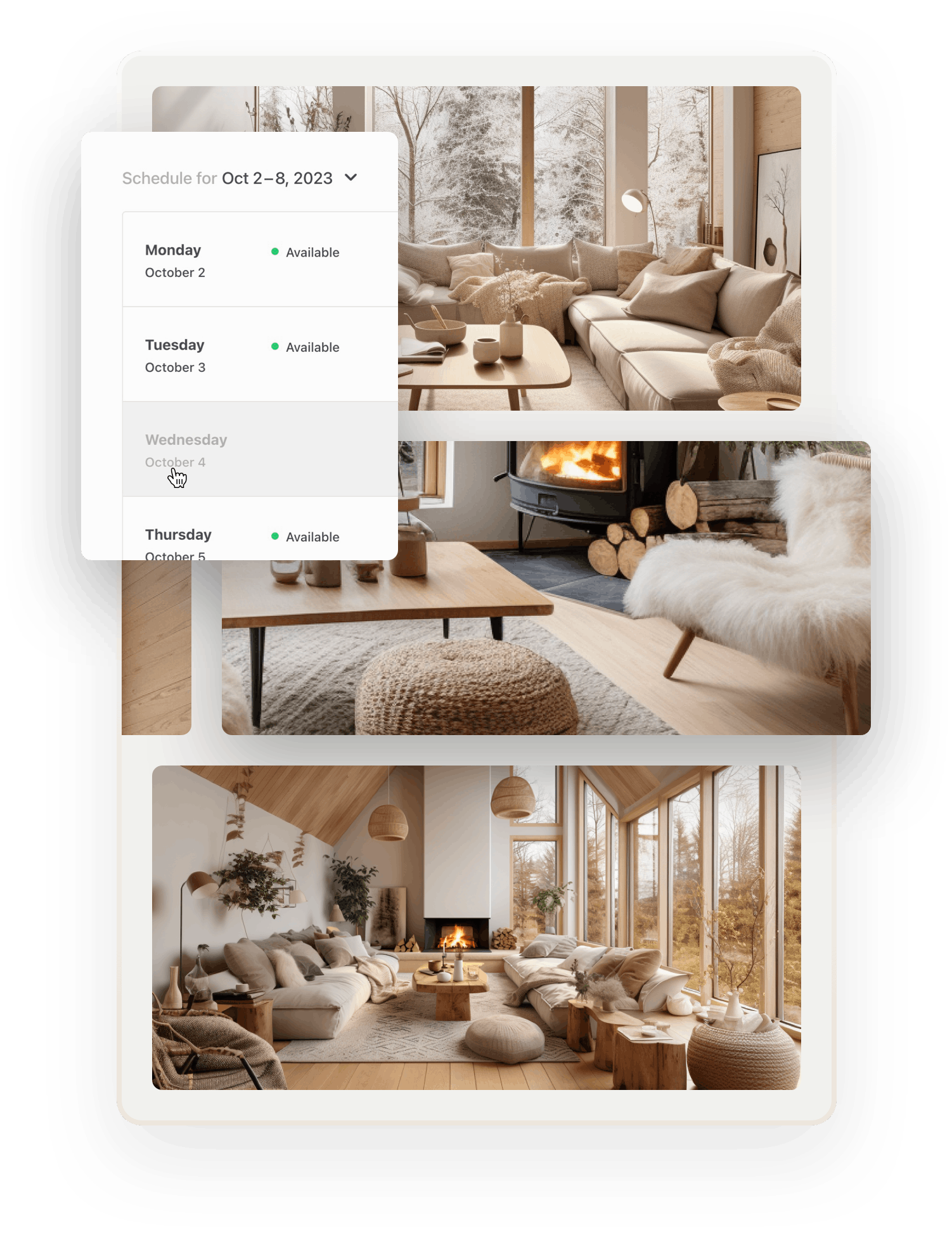
Classified sites like Craigslist connect customers and providers locally but don’t facilitate payments. Peer-to-peer rental marketplaces like Airbnb allow the customer to make a booking and pay through the site. This is critical if you wish to monetize through commissions because that requires the transaction to happen through your marketplace.
Robust payment functionality makes using the platform easy and convenient. Facilitated online payments are also safer than dealing with cash or direct payments. All these factors are crucial for building a successful marketplace business.
In addition, many Airbnb-like businesses add a layer of trust with a feature called delayed payouts. When payouts are delayed, buyers pay for a listing right away when they book it. The seller, however, receives the money only after the booking has passed.
Delaying payouts is a powerful way to ensure that both hosts and guests make bookings with honest intentions.
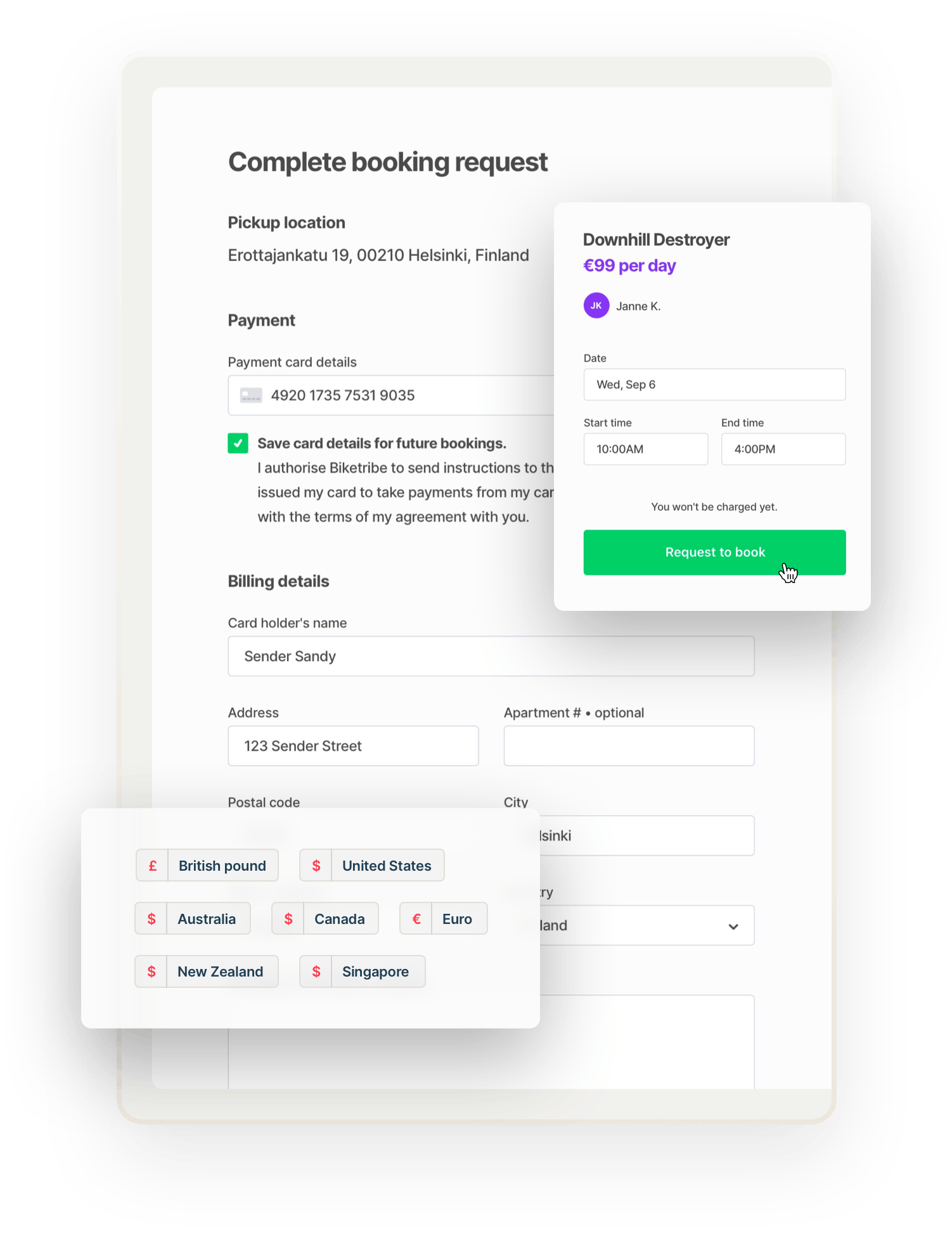
Online payments are subject to complex legal regulations. Charging a commission and delaying a payout add a lot of regulatory and technical complexity.
Suppose your platform isn’t powered by a tool like Sharetribe (which comes with a pre-built payment system, support for commission and various other monetization models, and integration to Stripe Connect). In that case, we strongly recommend you build an integration to a payment gateway with a dedicated marketplace offering. (Here’s our complete guide on marketplace payments with more information.)
Peer-to-peer marketplaces are based on trust between strangers. Online stores and platforms like Amazon usually ask customers to review the sellers. But on marketplaces like Airbnb, hosts also need to be sure their potential guests are trustworthy.
That’s why two-sided review functionality is a must. After a transaction, the buyer reviews the seller, and the seller reviews the buyer. Public reviews increase trust, and great reviews also boost sales.
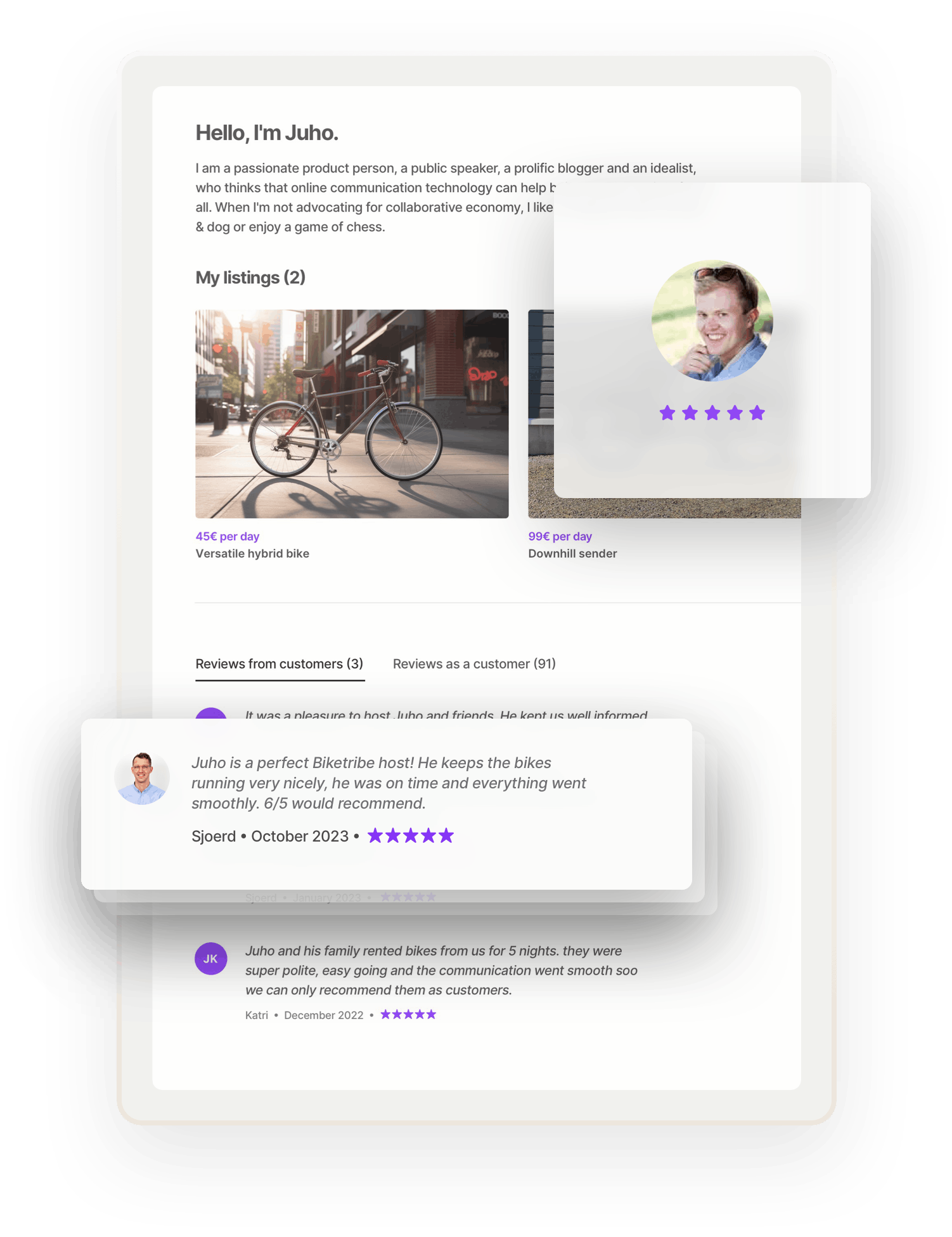
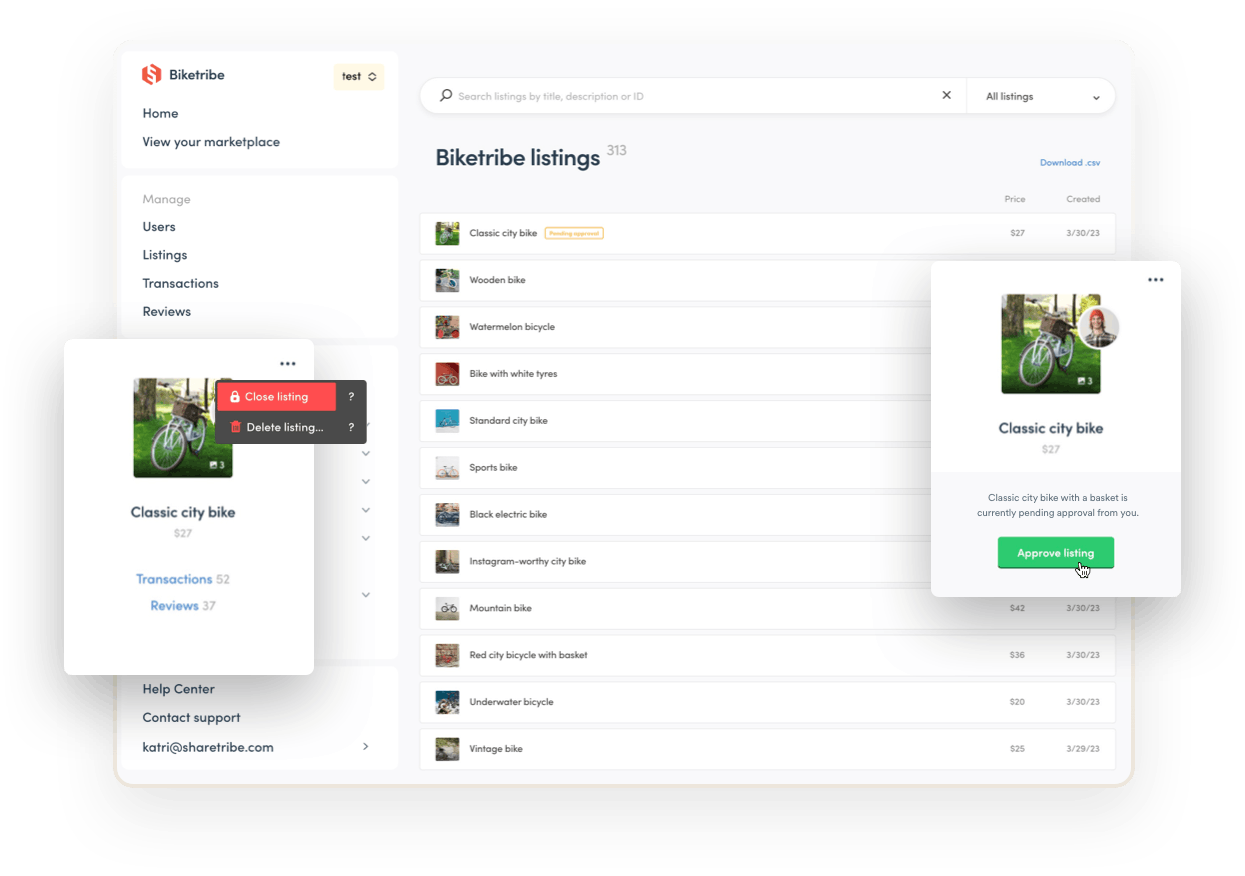
When Airbnb first launched, online marketplaces were completely new. While many things have changed since then, coding a similar location-based peer-to-peer rental marketplace can still be complicated, time-consuming, and expensive, depending on how you go about it.
Today’s marketplace entrepreneurs have alternatives that don’t require development skills or massive budgets. Today, the three most common ways to create a marketplace like Airbnb are:
- Coding from scratch
- Using a combination of no-code tools
- Using a marketplace builder
In addition to these approaches, there are several other ways to create a website like Airbnb. For example, you can use a generic website builder like WordPress with marketplace plugins.
While none of these can quite match the speed to market of dedicated no-code marketplace software or offer the same flexibility as custom development, they may fit your specific situation. If you’re looking for the right approach, read our article on choosing the right marketplace software.
Who is this best for? Experienced technical founders or founding teams with the time and skill to manage every aspect of development and maintenance
Estimated timeline: 6+ months to launch, even longer to refine and scale
Pros
- Complete control over features, design, and tech stack
- Scalable with no platform limitations
- Tailored architecture from the ground up
Cons
- Extremely time-consuming (6+ months minimum)
- Expensive (typically $50,000+ to launch, not including maintenance)
- Increasing security and maintenance costs as the platform scales
- High opportunity cost means less time for customer research, marketing, and iteration
Custom development gives you a lot of freedom to build and design your marketplace. But a marketplace is far more complex than your average web application. A custom development process is extremely time-consuming and heavy on upfront costs.
If you’re not a technical founder, hiring a developer to build your marketplace from scratch will require a budget in the five figures. Though development costs vary between agencies, even the most cost-efficient choice will likely set you back north of $50,000 just to launch your site. That sum won’t include the cost of third-party tools, maintenance, updates, hosting, or monitoring. You will still need to pay these costs every month.
If you’re already a software developer, you could more easily code from scratch. If you can build the frontend and backend yourself and are willing to take on the maintenance work, the costs will be limited to hosting and third-party tools. You can benchmark the Airbnb technology stack or get to work using the technologies you’re familiar with. Just use the programming language (Ruby, PHP, JavaScript, Python, Java, Clojure, etc.) you know best.
If you’re interested in exploring this option further, check out our guide on developing a marketplace app by our senior full-stack developer, Mikko. It’s a detailed guide to building a marketplace app from scratch and helps you estimate the project’s scope, choose your technology stack, and prioritize features and functionality.
However, even if there are no costs for the actual development work, there’s a significant opportunity cost you should consider:
Your time as a marketplace founder is your most valuable asset.
Is it really the best investment to spend it on developing marketplace basics?
Custom developing the bare essentials of a modern marketplace will take several months of focused work. And none of that work translates into a real competitive advantage because marketplace essentials are very similar across platforms.
For a founder with technical skills, we still recommend going with Sharetribe’s Developer Platform. You get the marketplace essentials built in and can spend your time and focus on adding your unique features and designs on top.
But what if you’re not technical and don’t have the budget (yet) to outsource development? Let’s look at other options for you.
Who is this best for? Entrepreneurs testing a niche concept or validating a new marketplace idea quickly and on a budget
Estimated timeline: 2 to 6 weeks to launch an MVP; will likely require a full rebuild later
Pros
- Fast to build (especially for MVPs)
- No technical skills required
- Tools like Webflow, Airtable, Zapier, and Stripe are flexible and easy to use
Cons
- Fragile setup since your platform depends on multiple tools working perfectly together
- Time-consuming to figure out user flows and feature requirements
- Limited scalability and customization
- Rebuilding is almost inevitable once you grow
Using no-code tools to launch your first version is a much faster way than custom development.
In fact, even if you do know how to code, we still recommend considering the no-code route first. Again, your time and focus are your most valuable resources, and no-code can free those up for more important work.
If you don’t want to go with a dedicated no-code marketplace builder like Sharetribe, you have the option to build your platform with a combination of no-code tools.
A common toolset could be:
- A website builder (like Webflow) for your landing page
- A tool like Typeform to collect data from your users
- Airtable to organize the data
- Calendly for calendar bookings
- MailChimp for marketing automation
- A payment provider like Stripe to process payments
- Zapier to connect all the tools together
- Or, if you’re a skilled Bubble user, you can build the entire site from scratch with Bubble
A setup that relies on an interplay of several different no-code tools isn’t necessarily the most solid, and things may easily break. But this might not be a concern if you’re only testing your concept for a limited time.
This setup is definitely not scalable, so when the time comes to expand your platform, you’ll need to rebuild it from scratch. Of course, this is a positive problem, not necessarily something to worry about on day one.
In our experience, the biggest drawback of this approach is that it can still take a considerable amount of time to figure out your feature requirements and get the blend of various tools working to your liking. If that means you’re spending time away from engaging with a real audience and learning how your idea works, the opportunity cost is just too high.
And even if scalability isn’t the biggest factor to consider at the MVP stage, you might be wise to spare some thought for the future.
Especially if you’re targeting a competitive market, you might need to invest in custom features soon to stand out from competitors. At that point, you might find yourself stuck between a rock and a hard place: not able to build anything custom with your current setup, and yet not able to pay five or six figures for a complete rebuild.
Who is this best for? Founders who want to launch quickly with a professional, scalable product and focus their time on growth, not infrastructure
Estimated timeline: 1 to 2 weeks for an MVP that is ready to scale from day one
Pros
- Fastest time to market (launch in 1–2 weeks)
- Built-in features designed for marketplace businesses
- No need for separate hosting, maintenance, or DevOps
- Most affordable long-term path, if you plan to scale
- Customizable with developer extensions
Cons
- No-code builders are less flexible than custom development at the code level (though often extensible with code)
- Sooner or later, your concept will likely require add-ons or custom features
If you have a business idea that works very similarly to Airbnb, using a marketplace software-as-a-service (SaaS) tool is by far the fastest way to market. That can mean ours at Sharetribe or an alternative, which we’ve listed and discussed in more detail here.
For example, Mike Williams launched a rental marketplace for music studios with Sharetribe in one day and grew it into the world’s largest before exiting.
Marketplace SaaS is also the easiest choice for non-technical founders. If your software gives you the essential marketplace website features, you can create a website similar to Airbnb in days instead of months. You won’t need to worry about hosting, maintenance, backups, or updates, and you can launch and run a marketplace entirely without coding.
Using a SaaS marketplace tool is great if you’re not a developer. Again, even if you are, this approach lets you validate your idea and find a product-market fit without spending months building your MVP.
Another significant benefit is that maintenance, security compliance, updates, and so on are usually taken care of. Especially at scale, this is usually the work of one or several DevOps engineers.
Building your marketplace with a ready-made tool doesn’t give you the same freedom as custom development. There will be some functionality unique to your marketplace idea that the no-code software does not support. But at the early stages, this is a reasonable trade-off for a faster time to market.
There are also marketplace builders available that allow custom features to be added on top of the no-code builder. Sharetribe is a pioneer in this category: our product lets you keep the no-code marketplace builder and add custom-coded features, designs, and integrations. (And if you don’t have a developer, our global network of Sharetribe Experts is there to help.)
The fastest way to get the first version of your marketplace out there and start learning from your users is to create a fully functional marketplace MVP with a no-code software tool like Sharetribe. Depending on your idea, you could move forward with a simple website and manually match your customers and providers! Whichever solution lets you launch fast while still delivering a great customer experience, that’s what you should go for.
Airbnb-like platforms need to handle complicated functionality from filtered searching, geolocation, and online payments to communication between the users and review systems. Building such a site from scratch requires a lot of work and technical skills, and that's why outsourcing development will nearly always cost well over $50,000.
Using dedicated marketplace software can help you save both money and time. Here are two example budgets for the first year of running a no-code, Sharetribe-hosted marketplace and a self-hosted, customized Sharetribe platform.
Create a no-code marketplace with Sharetribe
| Sharetribe Pro plan for 12 months (annual billing) | $2,388 |
| Domain registration for 12 months | $10 |
| Logo design – free (using a tool like Canva) | $0 |
| Stock images – free (using a service like Unsplash) | $0 |
| Blog and content marketing (included with Sharetribe’s Pages feature) | $0 |
| MailChimp email marketing – free up to 500 contacts | $0 |
| Google Analytics – free version | $0 |
| Total first-year marketplace budget with Sharetribe | $2,398 |
In this example budget, we assumed you’re using Sharetribe’s no-code builder to validate your idea, build your MVP, and keep costs to a minimum.
In addition to building a website, you’ll likely need to spend some money on building your brand and marketing your site. On top of the costs in the table, you may want to outsource design work; buy fonts, images, or certificates; and pay for ads or marketing solutions. However, there’s a lot you can do with affordable or free online tools.
Please note that the subscription does not include the time you spend building your platform. You can do this during your 14-day free trial, or with the Build plan ($39/month) if you need more time before going live.
Moving your marketplace to Sharetribe self-hosted
| Sharetribe Extend subscription for 12 months (annual billing) | $3,588 |
| Transaction fees for an average of 1,000 transactions per month (500 transactions included in the plan) | $1,140 ($95/month) |
| UX design and wireframes | $1,500 |
| Custom development | $5,000 |
| Front-end hosting | $360 |
| MailChimp Standard plan for up to 25,000 subscribers | $2,976 |
| Google Analytics – free version | $0 |
| Total first-year marketplace budget with Sharetribe Extend plan | $14,564 |
At this stage, you probably know your target audience well and have already generated some revenue to fund the development of your marketplace’s next version. Sharetribe is specifically designed to power websites similar to Airbnb with zero to minimal customization work.
If you don’t have a developer on your team, check out the Sharetribe Expert Network. We’ve partnered with carefully vetted agencies and freelancers who are happy to help you customize your Sharetribe marketplace.
However, please note that the budget above is a rough estimate. Prices for designs and development vary greatly depending on the Experts’ hourly fees and the extent of customizations you need for your idea. Still, compared to coding a marketplace from scratch, you are sure to save time and money, which you’ll be able to put into another critical aspect of growing a business.
This budget is for a comprehensive custom marketplace project. You could also add only one custom feature or modify your visual design while keeping the out-of-the-box functionality. In this case, the custom development or design fees would stay much lower.
Developing with Sharetribe is free for 14 days. You can then continue building with the Build plan ($39/month) and upgrade to a higher plan when you launch your marketplace and want to onboard actual users.
When your MVP is ready, it’s time to bring in your first users.
Usually, the best way to start building a marketplace audience is to start with the supply.
The supply tends to be more willing to sign up to a new platform with a promise of new demand, even if that demand isn’t there yet. Buyers, on the other hand, aren’t as flexible. If they visit a new marketplace and don’t find what they’re looking for, they leave and usually don’t return.
So, start by building an initial, high-quality supply before you open your marketplace to the demand.
In our experience, there are as many ways to find sellers as there are marketplace ideas. Some common ways include:
- Finding them in online forums and groups
- Visiting local meetups and events
- Visiting them in person
- Maybe becoming a supplier yourself
- Faking initial supply (scraping listings from the web or finding the listing your customer booked manually).
Airbnb famously contacted hosts on Craigslist and encouraged them to sign up on Airbnb, as Dave Gooden has documented.

This is where getting ideas and inspiration from other founders can be really helpful. Here are some resources:
Finally, your marketplace like Airbnb has a good amount of initial hosts (or whatever term you use for your supply).
Now is the right time to bring in just enough customers so that the supply and demand on your marketplace are well-matched. The faster you get both sides on your marketplace interacting, the sooner you learn if your idea has wings.
Note that by “launch,” we don’t mean a huge marketing effort with all the bells and whistles—not yet. The best time to do a proper “marketing launch” is later, when your initial audience is working and you’ve reached problem-solution fit (more on this step in the next section).
(And, as this tweet from Brian Chesky testifies, you can do a marketing launch several times if the first one didn’t make big enough waves.)
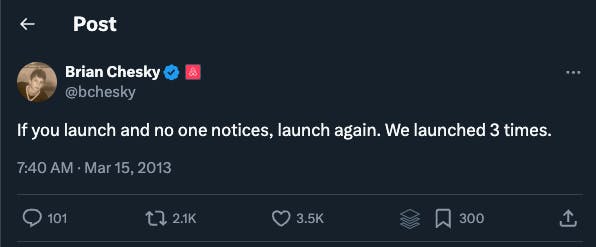
In the case of a marketplace like Airbnb, your initial supply might already have the key to unlocking demand. They might have existing customers and marketing channels of their own to bring to your marketplace—and if this is the case, you should definitely encourage them to do so.
You might also go to places similar to where you found your supply: online forums and local meetups. Paid search ads (like Google Ads) could also work, but make sure they’re really targeted so you don’t waste money on reaching too big a crowd.
When your supply and demand are in place, your next goal is to reach problem-solution fit.
Doing that validates that your marketplace idea works: you’ve identified a real problem and created a good solution for that problem.
It’s important not to start scaling your marketplace before reaching problem-solution fit and then product-market fit (more on this later).
So, how do you know that problem-solution fit is there?
The top signs are:
- You’re facilitating transactions regularly, on a recurring basis, and with less and less intervention from you.
- Your user base is growing (slowly and mostly organically through word of mouth—don’t invest in scaling yet!)
- Your marketplace liquidity is improving.
If these aren’t happening, don’t lose faith. This simply means you need to iterate. Go to your users, ask them what’s missing so they can have a great experience on your marketplace, and bring these lessons into your strategy and product.

After problem-solution fit comes product-market fit: validating that you’re targeting a good market with a product that can satisfy that market.
At this stage, it’s not enough for your marketplace to work. It needs to work consistently for a growing number of users. This is where metrics and KPIs become critical. You can’t rely on anecdotal feedback anymore. You need data that shows your platform is functioning as a real business.
Indicators of product-market fit on a marketplace are these key marketplace metrics:
- Liquidity: The most important metric. It measures the likelihood that a seller gets their listing sold and that a buyer finds what they’re looking for.
- Repeat-purchase rate: Shows how often users come back and transact again
- Gross merchandise value (GMV) retention: Measures whether transaction volume is growing among existing users
- Unit economics: Tracks whether you can profitably acquire and retain customers, specifically your CAC (customer acquisition cost) vs. CLTV (customer lifetime value).
To get those numbers up, this is likely the right time to:
- Expand your MVP: At this point, you’ll likely need to invest in custom features to attract more people to your platform and automate processes to reduce costs.
- Build a growth engine for your marketplace: Test different marketing tactics and see what works in your market. Depending on your exact marketplace idea, you might need different tactics to bring in more hosts or increase demand.
For Airbnb, these tactics included a host of manual and automated approaches. Early employee Jonathan Golden lists activities like:
- Meetups with hosts
- Outreach to targeted guests
- On-the-ground host referral campaigns
- “Latching on” to local events
- Encouraging employee travel to boost demand
You might also find that, similarly to Airbnb, there’s an overlap between guests and hosts on your marketplace. If this is happening, lean into this dynamic. Encouraging customers to also become sellers on your marketplace can be a huge growth lever.
After you’ve reached product-market fit, the sky is the limit.
You now know what works in your initial market. It’s time to apply those lessons learned—and maybe a handful of new tactics—to expand your reach into new markets.
The four stages of scaling your marketplace are:
- Decide how you’ll scale your marketplace (by adding a new category, new user group, or new location)
- Choose your next market
- Create a playbook
- Raise funding (if you need to)
In order to not stretch yourself too thin, it’s a good idea to expand into one new market at a time. According to Jonathan Golden, even Airbnb, a naturally global marketplace, saw benefits in a step-by-step approach:
“Our marketplace was global from day one, but there were numerous benefits to targeting specific geographies over a fixed period of time. We looked for tactics that showed promise, then figured out how to double down and get more sophisticated and scalable. There’s no single technique to credit with Airbnb’s early market growth; the sum of all of these strategies was greater than the parts. And your early course will rarely be linear. At one point, we were ramping up 50 markets simultaneously, and clearly spread too thin. After a moment of truth, we scaled back to a maximum of ten markets at a time.”
As you grow, marketing and distribution will start to matter even more. One of the most cost-effective ways to grow your marketplace is through content marketing and SEO. Evergreen blog posts, landing pages, and targeted guides can bring in new users while building your authority in your niche.
Technical SEO also plays a big role, as factors like site speed, structured data, internal linking, and crawlability can impact your visibility. If you haven’t already, use this technical SEO checklist to make sure your site is ready to scale.
It’s also important to recognize that launching is just the beginning. Ongoing support, iteration, and optimization are all part of the journey. You’ll need to monitor your user experience, refine features, fix bugs, maintain trust and safety processes, and continue to improve your marketplace based on real-world usage. This operational work may not be flashy, but it’s what turns a good platform into a long-term business.
Let’s conclude with a famous anecdote from the history of Airbnb. In its early stages, the founders contacted seven investors in an attempt to raise $150,000 at a $1.5M valuation (meaning that you could have bought 10% of Airbnb for $150,000).
Five rejected their pitch. Two didn’t reply. Founder Brian Chesky has shared screenshots of all five rejection emails and ends with an inspiring quote:
“Next time you have an idea and it gets rejected, I want you to think of these emails.”
![Screenshot of a rejection email from an investor sent to Airbnb cofounders reading: "Hi Brian, Apologies for the delayed response. We've had a chance to discuss internally and unfortunately don't think that it's the right opportunity for [blank] from an investment perspective. The potential market opportunity didn't seem large enough for our required model."](https://images.prismic.io/sharetribe/Z0cHh5bqstJ970Hn_Airbnb-investor-rejection.png?auto=format%2Ccompress&fit=max&w=611&h=227)
Creating a successful marketplace business is a big challenge. Building a powerful marketplace website is an important step—but not the whole story. What counts is how quickly you’ll be able to learn about your users, solve their biggest problems, and grow and expand iteratively.
The surest way to succeed is to focus on a clearly defined target audience and answer their needs better than anybody else. You’ll start learning about both when you launch your site.
The faster you launch, the quicker you can start learning about your audience. The more you learn, the better you can develop your offering to serve your audience better than any other solution.
We created Sharetribe with this process in mind. Our marketplace building platform is designed for launching fast and jumpstarting the learning process quickly and without coding. But it supports you just as well when you want to develop your business and platform further.
No matter which approach you choose, we hope this article helps you embrace the iterative approach. Validate your idea by first talking to potential users. Find a business model that supports you through the early stages and helps you grow. Identify your core features, choose a fast way to build them, and launch your minimum viable platform.
If you’re interested in reading more about the steps of building a marketplace, check out our guide on how to start an online marketplace. It offers lots of expert advice for marketplace entrepreneurs, regardless of how you decide to build your website.
Best of luck with your marketplace business!
Here are our answers to common questions about building a website like Airbnb.
It depends on your approach. A no-code marketplace builder like Sharetribe lets you launch for under $100/month, while a no-code stack may cost a few hundred dollars. Custom development usually starts around $50,000 and can go much higher.
No. With Sharetribe, you can launch a fully functional marketplace without writing a single line of code. If you want to customize your platform later, you can hire a developer or use our network of Sharetribe Experts.
It depends on your needs. Sharetribe is ideal if you want to launch fast, validate your idea, and scale over time with no-code and custom options.
The timeline depends on how you build your marketplace. Here are some estimates:
- With Sharetribe: 1 to 2 weeks
- With no-code tools: 2 to 6 weeks
- Custom development: 6+ months
Focus on a specific niche, region, or user group. Then offer a better experience or build trust in ways Airbnb can’t. Your competitive edge lies in your brand, not just your features.
Here��’s a basic toolkit:
- Email marketing: Mailchimp, ConvertKit
- Analytics: Google Analytics 4 (GA4), Plausible, Hotjar
- Help desk: Intercom, Crisp
- Content and visuals: Canva, Unsplash
Start your 14-day free trial
Create a marketplace today!
- Launch quickly, without coding
- Extend infinitely
- Scale to any size
No credit card required




